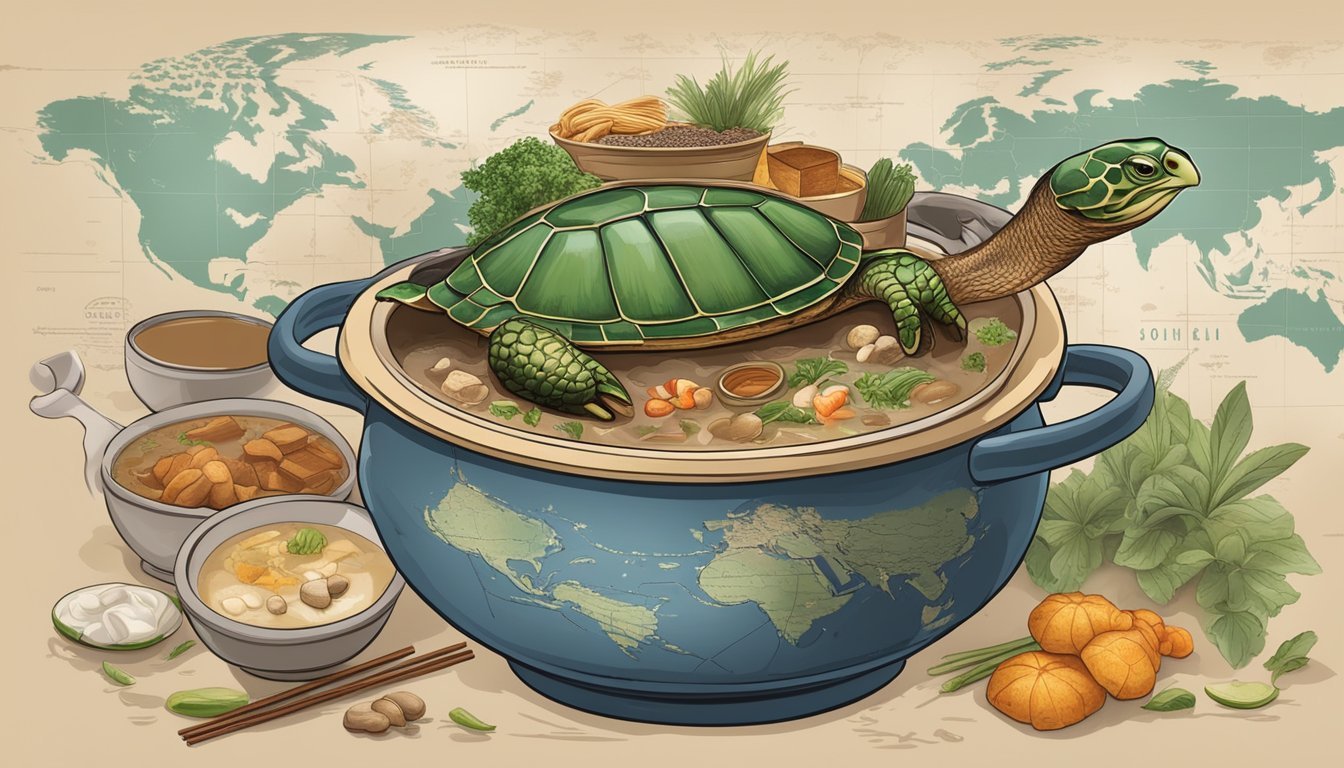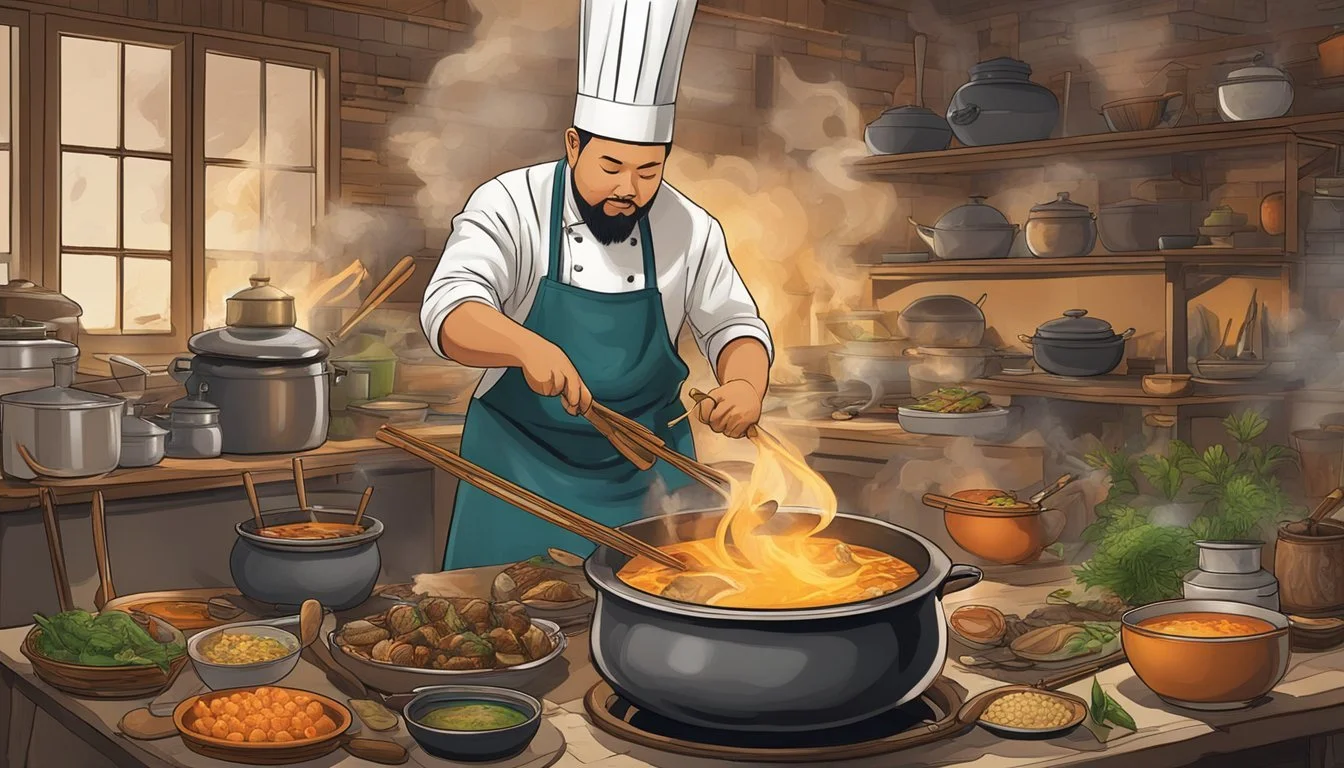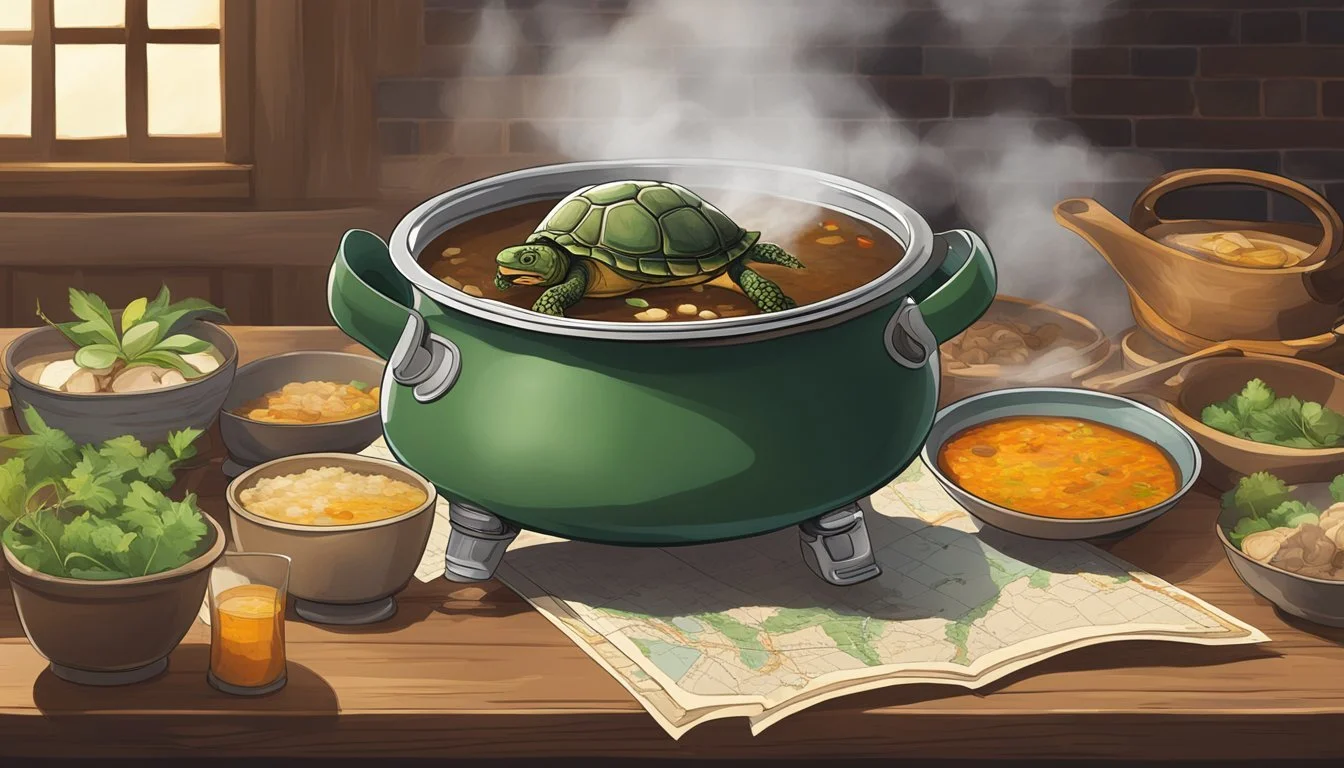Turtle Soup A Culinary Journey from Asia to the American South – Tradition & Tastes Explored
Turtle soup stands as a dish with a rich transnational history, tracing its origins from Asia and winding through the culinary traditions of the American South. Known for its distinctive flavor and often associated with upscale dining, the soup has symbolized both sustenance and status throughout different eras and regions. In Asia, particularly in China, the consumption of turtle soup has long been embedded in a complex culinary culture. It often incorporates aromatics and ingredients specific to the region, showcasing a blend of local tastes and cooking techniques.
As the soup made its voyage from Asia to the American South, it carried with it not only the flavors of exotic lands but also the influence of European culinary practices. In the American Colonies, and later in the United States, turtle soup evolved into a dish emblematic of Southern hospitality and opulence, often served at grand banquets. Inherited from English culinary traditions, the American adaptation of turtle soup frequently used green sea turtles sourced from the West Indies, making it a manifestation of the intertwined foodways of the transatlantic world.
The journey of turtle soup is a testament to the flow of species, tastes, and culinary knowledge across continents. Its presence in the American South is a historical thread that connects the region to a wider global narrative. The evolution of turtle soup reflects changes in social status, technological advancements, and international trade, making it a unique dish to explore both the past culinary practices and the interconnectedness of global food cultures.
Historical Context
The culinary tradition of turtle soup has traveled across continents and oceans, evolving through cultural exchanges and the influences of trade, colonialism, and culinary innovation.
Origins in Asia
Turtle soup's origins trace back to Asia, where the trade routes and local consumption practices first established the turtle as a valuable culinary species. Trading activities in regions such as Canton and Singapore were central to the turtle’s culinary journey. The soup likely began as a simple broth in Asia, evolving with culinary techniques and local tastes before being transported via the British Empire’s commercial networks.
Spread to the American South
Eventually, turtle soup reached the American South, becoming a delicacy particularly in places like New Orleans, which fostered a unique blend of European and local cuisines. The soup incorporated distinct American flavors and cooking methods, one being the terrapin version popular amongst Southern states. Mock turtle soup, using calf’s head as a substitute, also emerged as a cost-effective alternative, illustrating the dish's adaptation to resource availability in the region.
European Influence and Turtle Soup Fashions
European consumption of turtle soup became emblematic of wealth and fine dining, particularly among upper-class Europeans. By the eighteenth century, it had become a fashionable dish in England, shaped by colonial endeavors and growing trade with the Caribbean. The West India Way became symbolic of the soup’s journey, with recipes iterating in printed media like Mrs. Beeton's "Book of Household Management". Here, European cooks would use exotic ingredients to embody the prestige that turtle soup signified within English fashion.
Culinary Details
The culinary art of preparing turtle soup involves a careful selection of meat, seasonings, and techniques to create a dish known for its complex flavors. Traditionally, turtle soup utilizes the rich taste of turtle meat complemented by a blend of herbs, stock, and vegetables.
Turtle Meat and Its Preparations
Turtle meat is primarily harvested from sea turtles and, in North America, from diamondback terrapins. Its preparation starts with the cleaning and segmenting of the meat, often stewed to produce a rich base for the soup. Stock is created using turtle bones, adding depth to the broth. Cooking methods may vary, but slow simmering is essential to soften the meat and infuse flavors.
Ingredients for Stock:
Water
Turtle bones
Onion
Additional vegetables (as desired)
Seasoning and Taste Profile
A distinct taste profile is crucial to an authentic turtle soup. It is seasoned with salt, cayenne pepper, and aromatic herbs. Notably, mace and curry are spices that may be used for their warm, nuanced flavors. The soup often includes lemon to balance richness, and sherry or cream to round out the taste. The overall profile is savory with a bit of heat and subtle sweetness.
Typical Seasonings:
Salt
Cayenne pepper
Lemon
Herbs (e.g., parsley, bay leaves)
Spices (e.g., curry, mace)
Sherry
Cream
Regional Variations and Substitutes
Different cultures offer variations of turtle soup, such as the terrapin soup in Asia and the traditional soup savored at American turtle frolics. Mock turtle soup, made from calf's head or veal to replicate the texture and flavor of turtle meat, emerged as a substitute due to the decline in turtle populations. This variation maintains the essence with alternative ingredients.
Regional Variations:
Asia: Terrapin soup using diamondback terrapins
American South: Soup enjoyed at turtle frolics with indigenous spices
Substitutes:
Calf's head or veal for mock turtle soup
Turtle soup remains a revered dish, reflecting the histories and tastes of the regions it has traveled through, adapting and evolving through time.
Cultural Significance
Turtle soup has traversed continents and oceans, becoming a mirror to culinary tastes, socio-economic statuses, and cultural fusions. It holds a unique place in gastronomic history, reflecting the changing patterns of society and the movement of cultural trends and preferences.
Turtle Soup as a Status Dish
Turtle soup was once the embodiment of luxury and the exclusive pleasure of upper-class Europeans and American gourmands. In the culinary timeline, the consumption of turtle has transitioned from an exotic reference to a symbol of wealth. The soup, prepared with high-quality ingredients and careful culinary techniques, was often found at opulent banquets and became synonymous with high-status dining.
Literary and Travel Influences
The journey of turtle soup across continents has been meticulously documented by travelers such as Ida Pfeiffer. Her travelogue, starting in Vienna and stretching to Macao, among other exotic locales, portrays the intricate ties between exploration and gastronomy. Guides like Baedeker have cemented turtle soup's position in cultural narratives, interweaving the dish with stories of adventure and discovery.
Turtle Soup in Contemporary Society
In modern settings, turtle soup reflects both a homage to traditions and a controversial culinary topic due to the ethical implications of turtle consumption. Its American fate has seen it transform from a minority's staple to a regional delicacy in the Southern United States, with specific recipes and preparations shedding light on local ingredients and techniques adjusted over generations. It remains a dish that implies a historical legacy and contemporary debate.
Economic and Environmental Implications
The trade, culinary economy, and conservation efforts related to turtle soup bring to light the interplay between economic gain and environmental concerns, exposing both historical and ongoing challenges.
Trade and Markets
The transnational history of turtle soup reflects a once thriving trade, largely centered in the Caribbean and Atlantic, where sea turtles were sought after for their meat. Trade activities surged as turtle became a commodity, with markets adapting to demand. Money exchanged hands not only across the Atlantic but also as far-reaching as Asian markets, where the delicacy was also valued. The dissemination of turtle meat into restaurants illustrates the significance of turtle soup in the economic fabric of these regions.
Turtle Soup in Culinary Economy
In culinary spheres, turtle soup's rise from an exclusive class food to a wide-ranging mass food was propelled by advancements in food technology, such as canning in the late 1860s. This transition to mass production had pronounced economic implications, making turtle soup accessible to a broader audience and allowing producers to profit from larger scale sales.
Conservation and Legal Aspects
The environmental costs of the turtle soup trade have been stark. Over time, practices such as the outright massacre for sea turtle hunts led to the precipitous decline of various species, ushering in conservation measures. The practice of hunting sea turtles is now outlawed in many regions to protect these species from extinction. The melding of conservation and legal aspects has redefined the interaction between economic pursuits and environmental imperatives, forever altering the narrative of turtle soup within the global culinary economy.
Culinary Techniques and Tools
In the making of turtle soup, the precision of culinary techniques and the use of specialized tools have been crucial. Advancements in food technology over time have refined these aspects, enhancing the soup's complex flavors.
Tools of the Trade
The kitchen arsenal for preparing turtle soup includes sturdy stockpots necessary for simmering broths and turtle meat. Chefs also employ fine strainers to clarify stocks, ensuring a smooth soup base, and cleavers for portioning the turtle. Precise temperature control is pivotal, and modern stoves allow for consistent low heat, which is essential when simmering stocks to extract full flavors.
Essential Tools:
Stockpots
Strainers
Cleavers
Stoves with temperature control
Recipe and Methodology Evolution
Originally, conquerors and travelers relied on open fires and cauldrons to make turtle soup. Today, the methodology has evolved with an understanding of the importance of stock. It's commonly started by simmering bones in water, progressively adding mirepoix and aromatics. The introduction of Worcestershire sauce in the 1830s offered a tangy depth to the layered flavor profile.
Key Methodology Changes:
Open fire cooking to stove-top techniques
Introduction of stock as a base
Use of Worcestershire sauce
Garnishing and Presentation
In historical and modern presentations alike, turtle soup is often garnished with parsley, providing a note of freshness to balance the hearty flavors. The epicurean tradition of serving turtle soup garnished elaborately has somewhat simplified, yet the visual appeal remains important. Bowls are chosen to complement the rich color of the soup, and a sprinkle of herbs just before serving secures the aesthetic appeal.
Presentation Elements:
Fresh parsley as garnish
Soup bowls that enhance visual appeal
Popular Culture and Perception
The cultural imprint of turtle soup spans across media, social gatherings, and has even shaped regulatory dialogue. Historically, its presence on tables and its depiction in literature reflect societal views and shifts in environmental consciousness.
Media Portrayal and Printed Works
Turtle soup received notable mentions in travelogues and cookbooks dating back centuries, with its recipe and story traveling from the Atlantic to Canton. In the 19th and early 20th centuries, turtle soup was often depicted in printed media as an exotic delicacy, with its preparation and consumption being a reflection of status and refinement. Books and articles detailed the soup's significance and recipe variations, solidifying its image in culinary history.
Turtle Soup in Social Events
In the South, turtle soup was more than a meal; it was a central feature of communal events known as "turtle frolics," which were widely popularized social gatherings. Such events highlighted the communal aspect of consuming turtle soup and underscored the significance of turtles as a cultural commodity. The preparation and consumption of turtle soup served as both a social pastime and a status symbol during these events.
Prohibition and Public Sentiment
As environmental concerns emerged, the tides turned for turtle soup, particularly with green turtle species becoming endangered. This shift in public sentiment led to prohibition efforts aimed at preserving turtle populations in the Atlantic. These actions reflected a growing public awareness of wildlife conservation and a changing perception of turtle soup in the context of sustainability and ethical consumption.
Modern Serving and Consumption
In the modern culinary world, the tradition of serving turtle soup has been preserved through both classic and innovative approaches. Restaurants have tailored their menus to include this historic dish, and chefs continue to adapt recipes to suit contemporary tastes and ethical considerations.
Classic and Contemporary Recipes
Classic turtle soup recipes are rooted in a rich mélange of turtle meat simmered with ingredients like celery, garlic, bay leaves, and Madeira—a fortified wine from Portugal. Contemporary versions often maintain the foundational flavors but experiment with different textures and garnishes, such as sprinkling hard-boiled eggs on top for added richness.
Turtle Soup in Restaurant Menus
In areas like Louisiana, turtle soup remains a staple on menus, reflecting the region's culinary heritage. Restaurants often honor the traditional Creole preparation, which is characterized by a full-bodied stock, a roux base, and the holy trinity of bell peppers, onions, and celery, providing guests with an authentic taste of Southern cuisine.
Adaptations and Alternatives
With issues of sustainability and ethics influencing food choices, mock turtle soup has become more prevalent. It typically features ground beef as a substitute for turtle meat, capturing similar flavors without the use of actual turtle. Chefs may also utilize other meat alternatives to replicate the distinct taste and texture of traditional turtle soup, offering diners an ethical yet familiar option.







